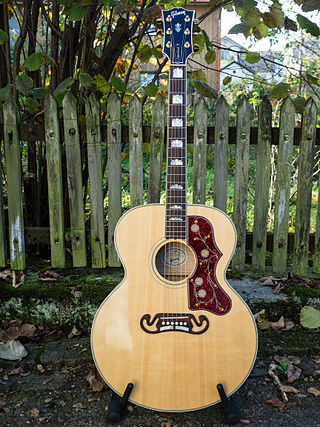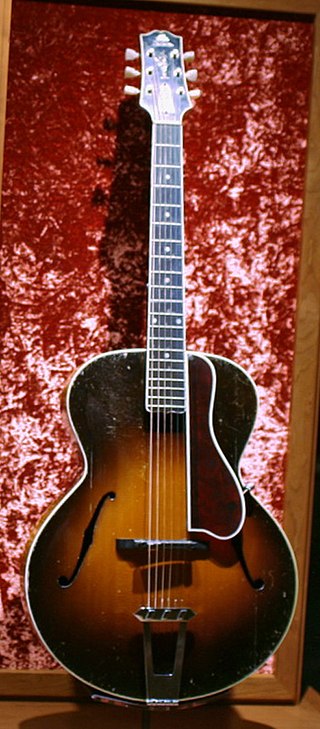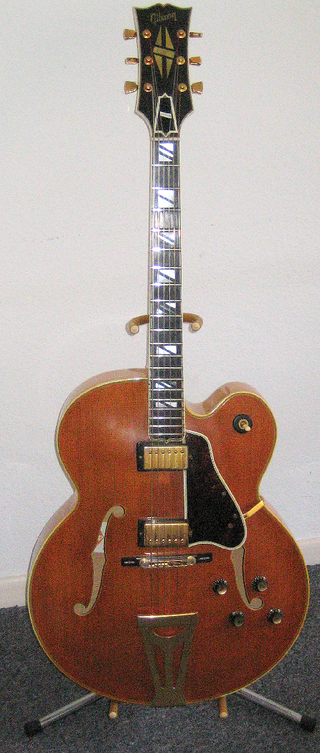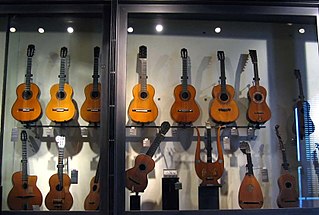
The steel-string acoustic guitar is a modern form of guitar that descends from the gut-strung Romantic guitar, but is strung with steel strings for a brighter, louder sound. Like the modern classical guitar, it is often referred to simply as an acoustic guitar, or sometimes as a folk guitar.

An electric guitar is a guitar that requires external electric sound amplification in order to be heard at typical performance volumes, unlike a standard acoustic guitar. It uses one or more pickups to convert the vibration of its strings into electrical signals, which ultimately are reproduced as sound by loudspeakers. The sound is sometimes shaped or electronically altered to achieve different timbres or tonal qualities via amplifier settings or knobs on the guitar. Often, this is done through the use of effects such as reverb, distortion and "overdrive"; the latter is considered to be a key element of electric blues guitar music and jazz, rock and heavy metal guitar playing. Designs also exist combining attributes of electric and acoustic guitars: the semi-acoustic and acoustic-electric guitars.

Jazz guitar may refer to either a type of electric guitar or a guitar playing style in jazz, using electric amplification to increase the volume of acoustic guitars.

Heritage Guitar is an American musical instrument manufacturer company based in Kalamazoo, Michigan, United States. The company produces a range of electric guitars, including hollow-body models.

The acoustic bass guitar is a bass instrument with a hollow wooden body similar to, though usually larger than, a steel-string acoustic guitar. Like the traditional electric bass guitar and the double bass, the acoustic bass guitar commonly has four strings, which are normally tuned E-A-D-G, an octave below the lowest four strings of the 6-string guitar.

The Gibson L-5 is a hollow body guitar first produced in 1923 by the Gibson Guitar Corporation, then of Kalamazoo, Michigan. The first guitar to feature F-holes, the L-5 was designed under the direction of acoustical engineer and designer Lloyd Loar, and has been in production ever since. It was considered the premier guitar of the company during the big band era. It was originally offered as an acoustic instrument, with semi-acoustic models not made available until the 1940s.

Epiphone is an American musical instrument brand that traces its roots to a musical instrument manufacturing business founded in 1873 by Anastasios Stathopoulos in İzmir, Ottoman Empire, and moved to New York City in 1908. After taking over his father's business, Epaminondas Stathopoulos named the company "Epiphone" as a combination of his own nickname "Epi" and the suffix "-phone" in 1928, the same year it began making guitars. From the 1930s through to the early 1950s, Epiphone produced a range of both acoustic and (later) electrified archtop guitars that rivalled those produced by Gibson and were the instruments of choice of many professionals; a smaller range of flat-top guitars were also produced, some designations of which were later continued during the Gibson-owned era for the company.

The Gibson ES-335 is a semi-hollow body semi-acoustic guitar introduced by the Gibson Guitar Corporation as part of its ES series in 1958. It has a solid maple wood block running through the center of its body with hollow upper bouts and two violin-style f-holes cut into the top over the hollow chambers. Gibson has released numerous variations and models based on the ES-335.

An archtop guitar is a hollow acoustic or semi-acoustic guitar with a full body and a distinctive arched top, whose sound is particularly popular with jazz, blues, and rockabilly players.
Variax was the name of a line of guitars developed and marketed by Line 6 between 2002 and 2023. They differed from typical electric and acoustic guitars in that internal electronics processed the sound from individual strings to model (replicate) the sound of specific guitars and other instruments. The maker claims it was the first guitar family able to emulate the tones of other notable electric and acoustic guitars. It also provided a banjo and a sitar tone. The Variax was available primarily in electric guitar models, but acoustic and electric bass guitar models have also been available in the past.

The electric mandolin is an instrument tuned and played as the mandolin and amplified in similar fashion to an electric guitar. As with electric guitars, electric mandolins take many forms. Most common is a carved-top eight-string instrument fitted with an electric pickup in similar fashion to many archtop semi-acoustic guitars. Solid body mandolins are common in 4-, 5-, and 8-string forms. Acoustic electric mandolins also exist in many forms.

The following outline is provided as an overview of and topical guide to guitars:

The Gibson ES-330 is a thinline hollow-body electric guitar model produced by the Gibson Guitar Corporation. It was first introduced in 1959 and the guitar had the same dimensions as the ES-335.

The Epiphone Casino is a thinline hollow body electric guitar manufactured by Epiphone, a branch of Gibson. The guitar debuted in 1961 and has been associated with such guitarists as Howlin' Wolf, Phil Upchurch, George Harrison, John Lennon, Paul McCartney, Noel Gallagher, Keith Richards, Dave Davies, Brad Whitford, Shirley Manson, Paul Weller, The Edge, Josh Homme, Daniel Kessler, Brendon Urie, Gary Clark, Jr., Glenn Frey, John Illsley, and Peter Green.
The Gibson ES series of semi-acoustic guitars are manufactured by the Gibson Guitar Corporation.

The Gibson ES-325 is a thinline hollowbody electric guitar model produced by the Gibson Guitar Corporation from 1972 to 1979.

The Gibson ES-137 is a semi-hollow-body guitar which was manufactured in Gibson's Custom Shop Memphis factory as a limited production run from 2002–2013. It was a relatively new design in Gibson's ES line which was not based on a vintage instrument, as many of Gibson's instruments are. The ES-137 is available in three models, Custom, Classic, and Standard.
The Fender Telecaster, colloquially known as the tele, is an electric guitar produced by Fender. Together with its sister model the Esquire, it was the world's first mass-produced, commercially successful solid-body electric guitar. Its simple yet effective design and revolutionary sound broke ground and set trends in electric guitar manufacturing and popular music. Many prominent rock musicians have been associated with the Telecaster for use in studio recording and live performances, most notably Bruce Springsteen, Prince, Luis Alberto Spinetta, Keith Richards and George Harrison.
Roger Rossmeisl was a German luthier who designed electric guitars in the 1950s and '60s for the US companies Rickenbacker and Fender.

Grimshaw Guitars was a British manufacturer of guitars and related instruments from the 1930s to the 1980s, known for producing acoustic archtop guitars in the 1930s–1940s, electrified archtop guitars in the 1940s and 1950s, semi-solid (thinline) electric guitars in the 1950s–1960s, and mainly solidbody guitars from the late 1950s to 1980s, along with smaller quantities of banjos, hawaiian guitars, electric bass guitars, acoustic guitars and nylon string guitars. Their archtop guitars were used by British players from the 1930s to the 1950s, when equivalent U.S.-made instruments were difficult to obtain in Britain, and their early electric thinline instruments such as the "S.S.1" and "S.S.1 deluxe" were popular with British "beat" groups of the early 1960s. Sales declined in the later 1960s and 1970s with easier access by customers to better made U.S. instruments at one end of the scale, and cheaper imported instruments, mostly from Japan, with which the Grimshaw line could not compete on price. The Grimshaw factory closed in the mid 1980s and its junior partner founder, Emile Grimshaw Jnr, passed away in 1987. Since that time, surviving instruments occasionally appear on the used market but tend to be somewhat overshadowed in favour of better known instruments of similar age by other British manufacturers such as Burns, Vox, etc.



















